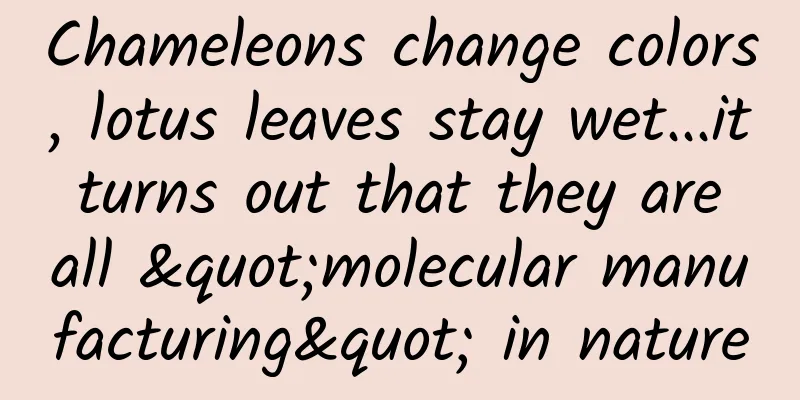Chameleons change colors, lotus leaves stay wet...it turns out that they are all "molecular manufacturing" in nature

|
How does the chameleon, the master of disguise, change color? Why can lotus leaves avoid getting wet? How do viruses accurately invade cells? … In the vastness of nature, magic is everywhere, which is incredible. What are the scientific principles behind these phenomena? What are these unique survival strategies and exquisite structural designs? This makes us sigh at the magical charm of molecular manufacturing in nature. While explaining the basis and concepts of molecular manufacturing, this article uses these three typical cases of animals, plants and microorganisms as a guide to explore the wonders of molecular manufacturing in nature, so as to better serve scientific and technological innovation and enable the development of new quality productivity. 1. Molecules: the basis of molecular manufacturing In 1811, the famous Italian chemist Avogadro published the molecular theory and proposed the concept of molecules: molecules are the smallest particles that can exist independently in a free state as simple substances or compounds. Molecules are composed of atoms. Simple molecules are composed of atoms of the same element, and compound molecules are composed of atoms of different elements. Molecules, as the basic units of matter, are the foundation of our survival. Through complex interactions, they jointly construct our physical world. Molecular manufacturing, as a technology for inducing, intervening and controlling the chemical reactions of molecules at the nanoscale and the assembly and self-assembly processes of molecular interactions, is not only a cutting-edge scientific technology, but also a miracle of nature at the microscopic level, which is worthy of our exploration and analysis. 2. Chameleon, the master of camouflage in the animal world: a miracle created by dynamic molecules Everyone knows that many animals can change color, but chameleons have the best camouflage ability. They can change five or six body colors to avoid invasion according to the surrounding environment, and are well-deserved "masters of camouflage." Because chameleons' skin contains a variety of pigment cells, these cells can change skin color by shrinking or expanding under the influence of light, temperature and other environmental factors. What’s even more amazing is that chameleons’ skin contains a special type of cell - iridophores, which can regulate the refraction and reflection of light by changing the structure of nanocrystals, achieving more complex color changes. When chameleons are in different environments or emotional states, the pigment cells and iridocytes in their skin work together to achieve rapid color changes through precise molecular regulation mechanisms. This dynamic molecular manufacturing process is not only amazing, but also provides important inspiration for humans to study color regulation mechanisms and develop new display materials. 3. The secret of lotus leaves not getting wet: molecular manufacturing of nanostructures Whenever we appreciate the beautiful lotus, we often see an interesting picture: the water droplets remaining on the lotus leaves not only do not soak the lotus leaves, but also roll freely on the lotus leaves, as if the surface of the lotus leaves is covered with an invisible film. When the wind blows the lotus leaves to sway, the water droplets will slide down and take away the soil in the lotus leaves. It's very magical! Scientists have conducted in-depth research on this phenomenon. In 1997, German botanist William Bartlott revealed the mechanism of lotus leaves not getting wet. Under a high-power electron microscope, we can observe that the surface of the lotus leaf is covered with many tiny papillae, and the intervals are very small. There are many concave parts between the papillae. When these concave parts are filled with air, a thin nano-level air layer will be formed in the place close to the leaf surface. This nano-level microstructure gives the lotus leaf a double-repellent effect, that is, it is neither wet nor oily. At the same time, the papillae are covered with a layer of waxy objects (wax sticks), which have a water-repellent effect, thereby further enhancing the waterproof performance of the lotus leaf. This characteristic of lotus leaves has greatly inspired human research and application in the fields of waterproof materials and self-cleaning surfaces. By imitating the nanostructure of the lotus leaf surface, scientists have developed a variety of high-performance waterproof and anti-fouling materials, promoting the progress of materials science. 4. The process of virus invading cells: precise manufacturing of molecular recognition As one of the smallest organisms in nature, the process of virus invading host cells is full of molecular manufacturing wisdom. This process can be roughly divided into five stages: adsorption, invasion, uncoating, biosynthetic assembly and release, among which adsorption and invasion are particularly critical. Because the adsorption protein on the surface of the virus needs to specifically match the receptor on the surface of the host cell to achieve accurate adsorption. This molecular recognition mechanism is the key to the success of viral infection and the core of its specificity. Once adsorption is successful, the virus can inject genetic material into the host cell in different ways to complete the invasion process. During the invasion process, the virus needs to overcome the host cell's defense mechanisms, such as the barrier function of the cell membrane. To this end, the virus has evolved a variety of strategies, such as using its own enzymes to degrade cell membrane components, or directly entering the cell by fusing with the cell membrane. The realization of these strategies is inseparable from the precise molecular recognition and interaction between the virus surface proteins and the host cell receptors. The process of virus invading cells is a vivid manifestation of the precision of molecular manufacturing in nature. It not only reveals the complex interaction between viruses and host cells, but also provides important clues for humans to study the mechanism of viral infection and develop antiviral drugs. V. Conclusion: Molecular manufacturing in nature and the enlightenment of human wisdom There are many molecular manufacturing miracles in nature, such as the color generation mechanism of butterfly wings, the pressure-resistant shell of sea urchin spines, and the production of natural rubber, etc. They not only demonstrate the exquisiteness and complexity of molecular manufacturing in nature, but also provide rich inspiration and materials for human scientific research and technological innovation. Through imitation and learning, scientists have developed cutting-edge products in the field of molecular manufacturing, such as wash-free clothing, flexible wearable batteries, and invisible cloaks, and have made major breakthroughs in many fields such as materials science, biomedicine, and information technology. In the future, as we deepen our research on the molecular manufacturing mechanism in nature, we are expected to develop more high-performance, intelligent new materials and technologies to serve the scientific and technological progress of mankind and the economic and social development. Let us pay attention to molecular manufacturing and keep moving forward on the road of forging the technological key to new quality productivity! Author: Xu Xilian, Hangzhou Science and Technology Workers Service Center, Hangzhou International Civilian Science and Technology Exchange Center. |
<<: Real-time "error correction" for quantum computers! Why don't you go to space, AI?
Recommend
More than 60% of consumers have misunderstandings about these 4 issues regarding food additives!
The use of food additives has a long history. Wit...
Reasons for freezing VIVO developer account and application process for unblocking
Reasons for freezing developer accounts and the p...
Did the iPhone create scalpers or did scalpers make the iPhone popular?
September has become the traditional date for App...
How much does it cost to customize a supplement mini program in Jining?
The launch of mini programs has brought convenien...
NetEase has launched an interesting new product. Here is an intern's full analysis and speculation about it.
Here is the text: The year 2016 is known as the f...
China Association of Automobile Manufacturers: A brief analysis of the sales of the top ten SUV manufacturers in January-February 2023
According to statistics and analysis by the China...
Which Zhejiang Mobile high bandwidth server rental company is the best?
Which Zhejiang Mobile high-bandwidth server renta...
Strategies for protecting children's health during flood prevention
Author: Li Linlin, Chief Physician, Affiliated Ho...
Henan Server Rental Fee Table
Henan server rental cost table, the cost of renti...
Apple products to watch in 2024: iPhone 16, Apple Intelligence, and other expected "Glowtime" releases
Apple will launch the iPhone 16 at its "It&#...
A quick guide to time management: Manage your time and become the master of it
Everyone is a manager of time, but most people ju...
How to achieve product growth through “circle fission”?
People in society are divided into different leve...
Radio and Television removes TV apps from shelves: industry and users in a lose-lose situation
The State Administration of Radio, Film and Telev...
Ren Zhengfei: Huawei can build a Hongmeng mobile phone system comparable to iOS in less than 2-3 years
On September 19, after the Huawei Mate 30 series ...
Beijing is under blue warning for heavy rain! Please be careful when staying at home or traveling →
Monday morning rush hour Beijing, Tianjin, Hebei ...









